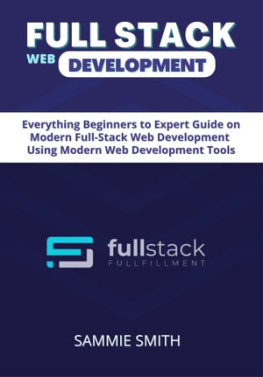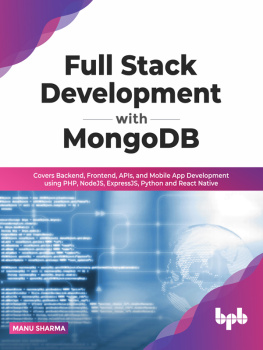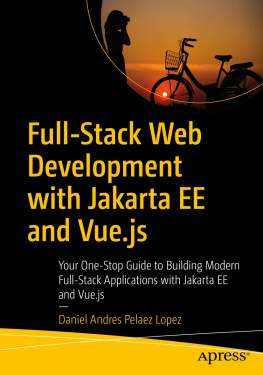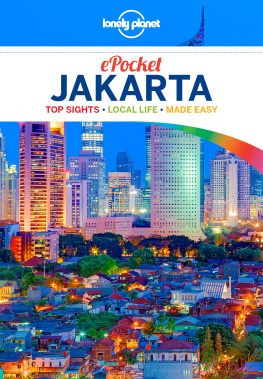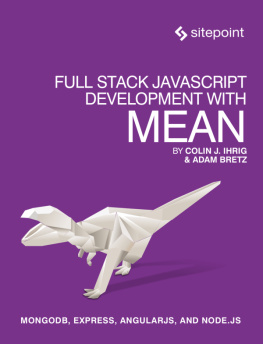Marto Torres - Full-Stack Web Development with Jakarta EE and Vue.js
Here you can read online Marto Torres - Full-Stack Web Development with Jakarta EE and Vue.js full text of the book (entire story) in english for free. Download pdf and epub, get meaning, cover and reviews about this ebook. year: 2021, publisher: UNKNOWN, genre: Computer. Description of the work, (preface) as well as reviews are available. Best literature library LitArk.com created for fans of good reading and offers a wide selection of genres:
Romance novel
Science fiction
Adventure
Detective
Science
History
Home and family
Prose
Art
Politics
Computer
Non-fiction
Religion
Business
Children
Humor
Choose a favorite category and find really read worthwhile books. Enjoy immersion in the world of imagination, feel the emotions of the characters or learn something new for yourself, make an fascinating discovery.

- Book:Full-Stack Web Development with Jakarta EE and Vue.js
- Author:
- Publisher:UNKNOWN
- Genre:
- Year:2021
- Rating:4 / 5
- Favourites:Add to favourites
- Your mark:
- 80
- 1
- 2
- 3
- 4
- 5
Full-Stack Web Development with Jakarta EE and Vue.js: summary, description and annotation
We offer to read an annotation, description, summary or preface (depends on what the author of the book "Full-Stack Web Development with Jakarta EE and Vue.js" wrote himself). If you haven't found the necessary information about the book — write in the comments, we will try to find it.
Full-Stack Web Development with Jakarta EE and Vue.js — read online for free the complete book (whole text) full work
Below is the text of the book, divided by pages. System saving the place of the last page read, allows you to conveniently read the book "Full-Stack Web Development with Jakarta EE and Vue.js" online for free, without having to search again every time where you left off. Put a bookmark, and you can go to the page where you finished reading at any time.
Font size:
Interval:
Bookmark:
About the Author xv About the Technical Reviewer xvii Acknowledgments xix Introduction xxi
Technical Requirements 1
Summary 24
Extended Knowledge 24
Technical Requirements 25
Summary 62 Extended Knowledge 62
Technical Requirements 64
Summary 109
Extended Knowledge 110
Summary 141
Questions 142
Technical Requirements 144
Summary 211
Technical Requirements 214
Summary 253
Extended Knowledge 253
Technical Requirements 255
Summary 297
Extended Knowledge 298
Technical Requirements 299
Summary 332 Extended Knowledge 333
Technical Requirements 335
Summary 366
Extended Knowledge 367
Technical Requirements 369
Summary 400
Extended Knowledge 400
Technical Requirements 402
Summary 458 Extended Knowledge 459
Technical Requirements 462
Summary 508
Extended Knowledge 508
Technical Requirements 509
Source S3 511
CodeBuild in Develop and Production Environment 513
Active Approval 533
Configure the Pipeline through the AWS Console 535
Summary 559
Extended Knowledge 560
In this chapter, we are going to cover the basics of full-stack development with Jakarta EE, talking about general concepts and the environments installation, so that you will understand where and how to start your full-stack project in a hands-on manner.
The following topics will be covered in this chapter:
Understanding Java EE and Jakarta EE basics
Using GlassFish application server as an example
Environment installation
Understanding Jakarta EE project structure
Java 1.8
Netbeans 11
Eclipse GlassFish
Java Enterprise Edition
Jakarta Enterprise Edition
We are not going to cover Java 1.8 installation in this chapter.
You can check the whole project and code at https://github.com/Apress/full
stack-web-development-with-jakartaee-and-vue.js/tree/master/CH1/ .
There are a lot of back-end technologies in different languages and with different features. In this book, we are going to cover Jakarta Enterprise Edition as our back-end framework.
Java Enterprise Edition is an enterprise standard created by Sun Microsystems (later bought by Oracle Inc.) that uses different specifications to enrich web applications, from database access to RESTful services. There you will find:
Well-known standards and specifications like JAX-RS or JPA. A programming models based on layers.Highly featured application servers supporting those standards.
A well-constituted community of developers and companies using the specification.
Note We are not going to cover the details of how the specification is created and validated in this book. However, I suggest you read more about this interesting process through different people and organizations here: https://javaee. github.io/javaee-spec/ .
Java EE applications have been in the market for a long time, from J2EE 1.2 (December 12, 1999) until today, with the current version being Java EE 8 (August 31, 2017). You can have a look at the list of version releases at https://en.wikipedia.org/ wiki/Java_Platform,_Enterprise_Edition .
Note For the purposes of this book, we assume you have a basic understanding of Java EE applications.Today, a lot of companies have their systems over the Java EE platform due to their robust application servers and pretty good support. However, its evolution has been slow and other frameworks in the Java ecosystem have shown up, like Spring or Play.
For its own reasons, Oracle Inc. made the choice to open source theJava EE specification. You will learn more details about this in the next section.Java EE has been a great tool to build enterprise applications using Java. However, its evolution has been slower in comparison to other similar frameworks like Spring Framework.
As it was slowly evolving, the leading software vendors (including Oracle Inc.), who supports and implements Java EE , collaborated to move Java EE as open source and named Jakarta EE , handled by the Eclipse Foundation, to boost up its development and evolution.
Tip Java EE is the oracle trademark;thats why the name was changed. You can find more information here: https://blogs.oracle.com/theaquarium/ the-road-to-jakarta-ee
In September 2019, Jakarta EE 8 was released by the Eclipse Foundation. In addition, Eclipse released the Eclipse GlassFish 5.1 application server fully compatible with Jakarta EE 8 . This first release was not a huge technical one but was more about negotiations, processes, and specifications related to the open sourcing strategy. Also, the Eclipse Foundation released the first Java API specification, changing from the javax.* namespace (Java EE ) tojakarta.* namespace (Jakarta EE ).
Jakarta EE wont stop here, as new versions are being planned for release.Note You can find more information here:https://www.infoworld.com/ article/3437783/eclipse-jakarta-ee-arrives.html
From here, we are going to useJakarta EE as a specification reference.
An application server is a comprehensive framework that allows us to create web applications, giving us a set of tools and APIs to facilitate our job. Jakarta EE is a set of specifications defined for application servers. So, in the market, at the time I wrote this book, you find Eclipse GlassFish , OpenLiberty, and WildFly as servers supporting Jakarta EE. You can find more information here: https://jakarta.ee/compatibility .
Note For Java EE, there are more servers like Jboss,tomcat EE, Weblogic, and so on.The Eclipse GlassFish application server is a fully compliant server for Jakarta EE standards and specifications. GlassFish is usually the first server that gets updated when a new Jakarta EE specification arrives.
We are going to install GlassFish through Netbeans IDE in the following section.Netbeans is the default IDE used when developing an application using Java EE. It has the latest Java EE integrations and plugins and is up to date with the current specification; however, it is not upgraded yet to use Jakarta EE by default.
Until Netbeans 8.2, Oracle Inc. handled and sponsored it. After that version, Oracle released the IDE as an open source project to Apache. We have now the 11 incubating version, which has enough features to work with Jakarta EE
For the purposes of this book, we are going to use Netbeans as a default IDE; however, you can choose one at your discretion or just use your favorite one.Note For more information on netbeans and Java EE compatibility, you can have a look at the questions posted at https://stackoverflow.com/ questions/45852077/netbeans-how-to-add-a-javaee-version and https://stackoverflow.com/questions/46528103/upgradenetbeans-to-jee-8 .
Tip at the time of writing this book, Intellj IDE supports Java EE in the ultimate edition.Netbeans 11.1 was released while we were writing this book; however, it is in an unstable state. You can see more information here: https://netbeans. apache.org/download/nb111/index.html .
Font size:
Interval:
Bookmark:
Similar books «Full-Stack Web Development with Jakarta EE and Vue.js»
Look at similar books to Full-Stack Web Development with Jakarta EE and Vue.js. We have selected literature similar in name and meaning in the hope of providing readers with more options to find new, interesting, not yet read works.
Discussion, reviews of the book Full-Stack Web Development with Jakarta EE and Vue.js and just readers' own opinions. Leave your comments, write what you think about the work, its meaning or the main characters. Specify what exactly you liked and what you didn't like, and why you think so.


